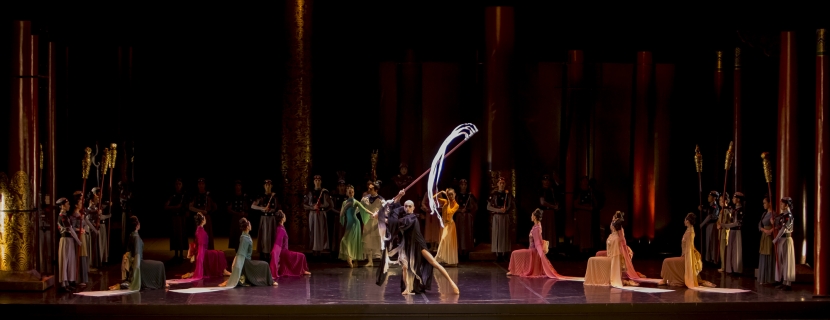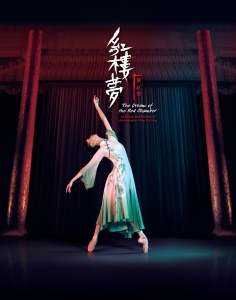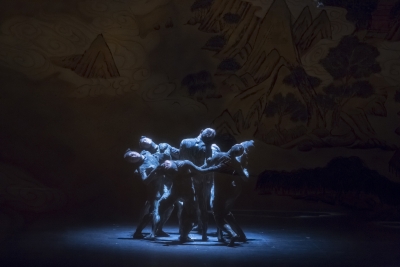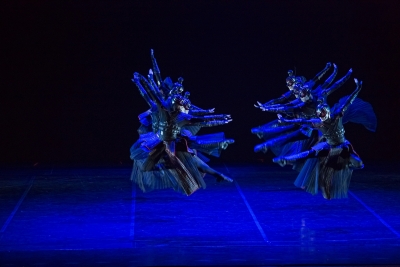
Hong Kong Ballet has never attracted so much public attention until its premiere of the ballet The Dream of the Red Chamber based on Cao Xueqin’s classic Chinese novel. This new ballet is choreographed by Wang Xinpeng who originally created it last year for the Ballett Dortmund of which he is the artistic director.
After the premiere on 25 October, Hong Kong Ballet made some controversial cuts to Act 3 without the choreographer’s permission for the remaining four performances of that first weekend. (Wang, interviewed by Ming Pao on 3 November, denied having authorized those cuts.) The cuts were widely reported and condemned by the local media as an act of “self-censorship”. Cuts included a projected video in Act 3 comprising old news broadcasts including material from the Cultural Revolution, and a short scene with extras dressed as Red Guards waving the red Mao books. But fortunately, those cuts were restored in the second weekend of performances after all the media outcry; as I can verify after attending the performance on 1 November as well.
This original and thought-provoking ballet lasting 2 ½ hours is divided into three acts and framed by a prologue and epilogue. The music score is by Michael Nyman isn’t particularly conducive to dancing, and lacks memorable music for the duets, but is reasonably effective overall. Wang has pared down the novel to the central love story of Lin Dai Yu and her cousin Jia PaoYu who is forced by the Jia matriarch to marry instead his other cousin Xue Pao Tschai.
The prologue depicts Pao Yu’s birth after a stone has come into this world in human existence. The solo by a grey-clad male dancer representing the stone however drags on for too long. Act 1 is more dramatically cogent, concentrating on the love triangle between the three leading characters up to the wedding celebrations. The shorter Act 2 is about Dai Yu’s grief after Pao Yu’s wedding to Pao Tschai and ends with Dai Yu’s death after she’s burnt the poems that she’s written for Pao Yu. It is theatrically depicted by the huge scrolls of calligraphy in the background crashing down the stage after some red lighting.
 Act 3 meanders slightly in the beginning and loses its focus at times. Nevertheless there is a beautiful dream scene with the female corps de ballet dressed as green nymphs and a moving duet for Pao Yu and Dai Yu who appears in his dream. Then the choreographer Wang transports the audience through time. As Pao Yu dances a long intense solo in front of a huge red wall in the background, which also represents Tiananmen Square, cracks appear on the wall. The cracks signifify the decline of the wealthy Jia family. (The cracks however didn’t appear on the second night which I also attended.)
Act 3 meanders slightly in the beginning and loses its focus at times. Nevertheless there is a beautiful dream scene with the female corps de ballet dressed as green nymphs and a moving duet for Pao Yu and Dai Yu who appears in his dream. Then the choreographer Wang transports the audience through time. As Pao Yu dances a long intense solo in front of a huge red wall in the background, which also represents Tiananmen Square, cracks appear on the wall. The cracks signifify the decline of the wealthy Jia family. (The cracks however didn’t appear on the second night which I also attended.)
Then inexplicably there follows a long procession of courtiers dressed in Qing dynasty costumes almost like a cat walk in a fashion show, and with absolutely no dancing at all. And simultaneously on the red wall, there is a 12-minute-long video projection of newsreel films charting China’s turbulent history from the Empress Dowager Cixi through the Sino-Japanese war up to the Cultural Revolution. (This video was cut out on the second night.)
The video and the pointless fashion parade then give way to a more exciting ensemble dance. Dancers, attired in green unitards with red scarves attached, represent the Red Guards. And in the middle of this, there is a short scene of more extras attired in unmistakable Red Guard costumes and waving the red Mao books. Undoubtedly this is one of the most engrossing and powerful parts of this production, which could have provided the ballet with a rousing ending. (On the second night, the red scarves attached to the dancers’ costumes were gone, and short Red Guards scene was also cut.)
Instead the subsequent epilogue set in our present time is feeble and rather muddled. We see Pao Yu now as a monk, and the other main characters like Dai Yu and Pao Tschai in modern clothing. There is also a scene with two garbage collectors cutting down the begonia tree, which has earlier appeared in the first two acts. This drew laughter from the audience, which I don’t think is intended by the choreographer.
This ballet overall is stronger in theatrical power than in choreography. Wang’s choreography is average, and includes some fine duets and solos for the three lead characters. The ballet can do with some fine-tuning and tightening, as it feels slightly disjointed in Act 3. However to be fair, it’s not the complete version shown by Hong Kong Ballet even on the first night. Some scenes in the original Dortmund version depicting the Red Guards destroying the historical treasures had already been cut by Hong Kong Ballet even before the premiere. So it’s possible that these earlier cuts may have compromised this Hong Kong version.
Li Jia-bo was excellent as Pao Yu, giving the best performance of his career so far. Liu Yu-yao was lovely in her long ethereal line, and sailing through her several demanding solos with ease. She was tender in the duets, and conveyed perfectly Dai Yu’s beauty and fragility. Zhang Si Yuan was delightful as Pao Tschai. The whole company was on top form. Praise must be also made to the sumptuous sets and costumes designed respectively by Frank Fellmann and Han Chunqi.
Kevin Ng has been writing about dance since 1997. He has contributed to a number of publications including the Hong Kong Economic Journal, Time Out Hong Kong, Financial Times, Wall Street Journal Asia, South China Morning Post, Ballet Review (USA), and Ballet 2000 (Italy).
Photo: Hong Kong Ballet (Poster Photo © Almond Chu, Other Photos © Colin Lam)






